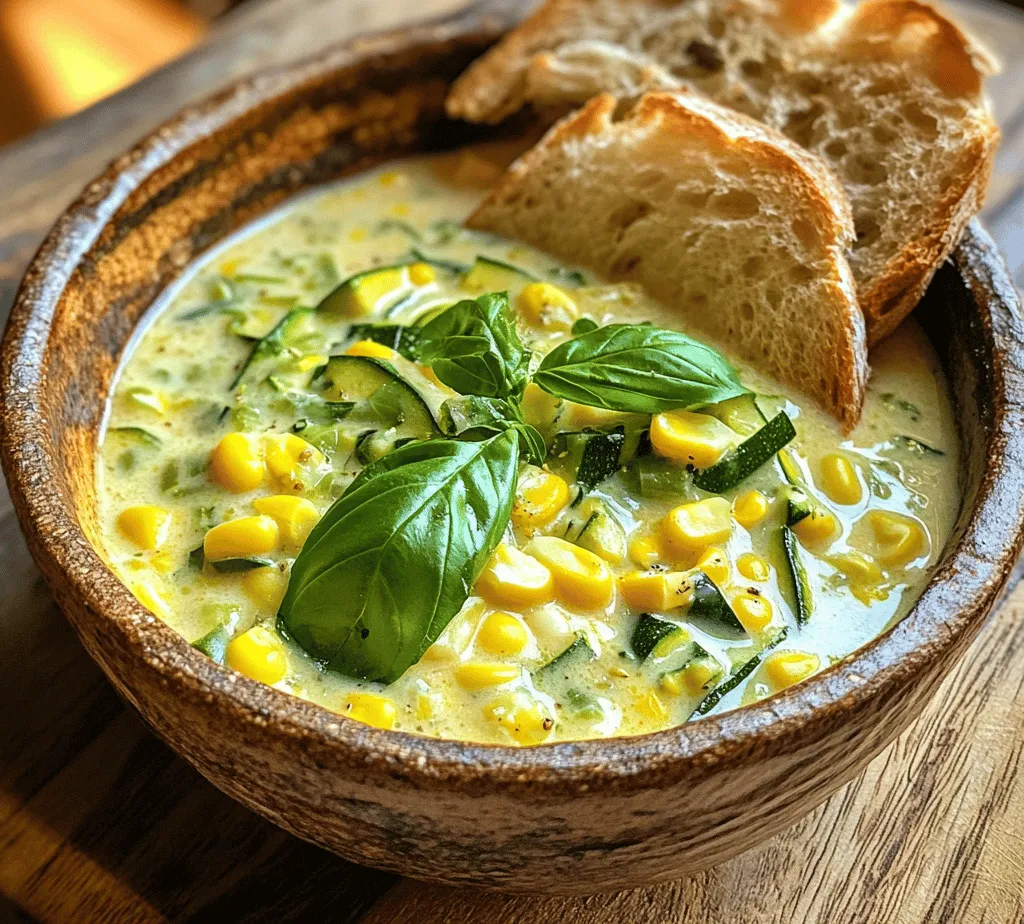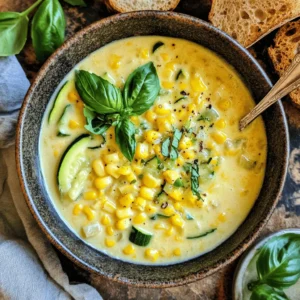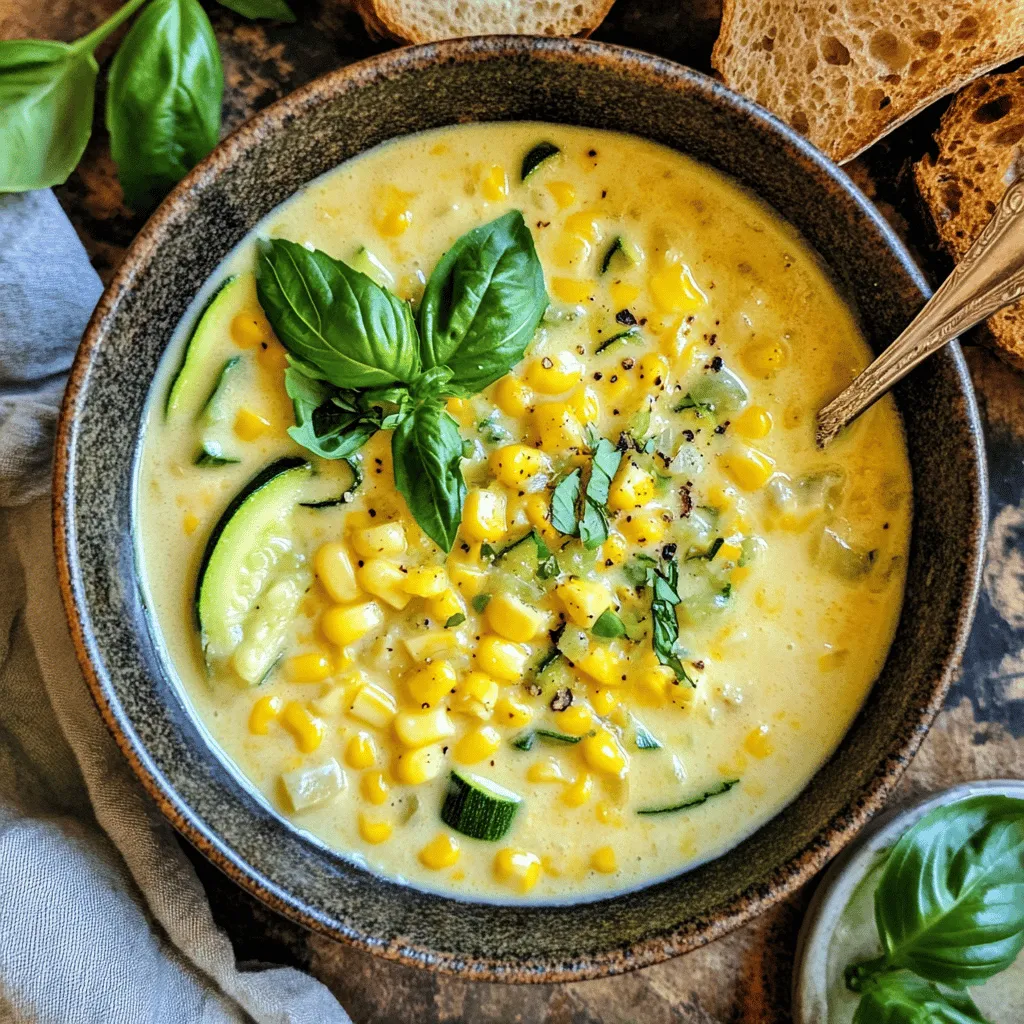Introduction
As summer rolls in, a delightful wave of fresh produce floods farmers’ markets and grocery stores alike. It’s the perfect time to celebrate the season’s bounty with a refreshing dish that embodies the flavors of summer. Enter the Creamy Summer Corn and Zucchini Chowder—a luscious, comforting bowl of goodness that not only warms the soul but also tantalizes the taste buds. This chowder showcases the vibrant colors and flavors of the freshest ingredients, making it an ideal choice for a light lunch or a cozy dinner on a warm evening.
The appeal of this dish lies in its simplicity and the way it highlights the natural sweetness of corn paired with the mild, buttery flavor of zucchini. With each spoonful, you’ll experience the essence of summer, making it a beloved recipe that can become a staple in your kitchen.
Plus, the importance of using locally sourced produce cannot be overstated. Not only does it support local farmers, but it also ensures that the ingredients are at their peak freshness, leading to a more flavorful and nutrient-rich meal. In this article, we will explore the essence of summer through corn and zucchini, delve into the ingredients that make this chowder truly special, and guide you through the initial steps of creating this delicious dish.
The Essence of Summer: Why Corn and Zucchini?
Corn and zucchini are quintessential summer vegetables that shine in this chowder, elevating it from a simple soup to a vibrant celebration of the season. Corn, with its sweet kernels, is often associated with summer barbecues and picnics, while zucchini’s versatility makes it a popular choice for a variety of dishes. Together, they create a harmonious blend of flavors that perfectly encapsulates the warmth of sunny days.
Nutritional Benefits of Corn and Zucchini
Both corn and zucchini offer a range of health benefits that make them excellent choices for your summer meal planning. Corn is not only a delicious source of carbohydrates but also provides essential vitamins and minerals. It is rich in dietary fiber, which aids digestion and contributes to heart health. Additionally, corn contains antioxidants like lutein and zeaxanthin, which support eye health.
Zucchini, on the other hand, is low in calories and packed with nutrients. This summer squash is an excellent source of vitamin C, potassium, and folate. Its high water content keeps you hydrated, making it a refreshing addition to your meals during the hot summer months. The combination of these two vegetables not only enhances the flavor of the chowder but also boosts its nutritional profile, making it a guilt-free indulgence.
Seasonal Availability and Sustainability of Ingredients
Choosing seasonal ingredients is key to a sustainable cooking practice. During the summer months, corn and zucchini are often harvested at their peak, ensuring the best flavor and texture. Supporting local farmers by purchasing these ingredients at farmers’ markets or through community-supported agriculture (CSA) programs not only helps to reduce your carbon footprint but also strengthens your local economy.
By opting for fresh, local produce, you contribute to sustainable agriculture and promote biodiversity. This practice minimizes the environmental impact associated with long-distance transportation and encourages a more diverse diet, which is beneficial for both health and the planet.
Ingredients Breakdown
To make a delicious Creamy Summer Corn and Zucchini Chowder, it’s essential to understand the role of each ingredient. Each component not only adds flavor but also contributes to the overall texture and health benefits of the dish. Here’s a detailed examination of the key ingredients that will make your chowder a standout.
Zucchini: Nutrition and Versatility
Zucchini is a star ingredient in this chowder, providing a mild flavor and a creamy texture when cooked. This versatile vegetable can be enjoyed in numerous ways—grilled, sautéed, spiralized, or even baked into desserts. Nutritionally, zucchini is a low-calorie food that offers high levels of vitamin C and manganese, both of which are essential for maintaining healthy skin and supporting metabolic functions.
When selecting zucchini for your chowder, look for small to medium-sized squashes that are firm and shiny. Avoid those with blemishes or soft spots, as they may not provide the best flavor. In this chowder, zucchini adds volume and a subtle earthiness, making it an essential ingredient.
Fresh Corn: Taste Profile and Health Benefits
Fresh corn is at the heart of this chowder, bringing its signature sweetness and crunch to each bite. The taste of freshly harvested corn is unparalleled, with its juicy kernels bursting with flavor. Rich in carbohydrates, corn provides energy while also being a good source of fiber, which aids in digestion and helps you feel full longer.
In addition to its delightful flavor, corn is loaded with nutrients. It contains essential vitamins such as B vitamins (including thiamine and folate), which play a crucial role in energy production and red blood cell formation. When preparing this chowder, using freshly shucked corn will elevate the dish and ensure you capture the essence of summer.
Onion and Garlic: Flavor Enhancers and Health Properties
Onion and garlic are two aromatic ingredients that serve as the foundation for many soups and chowders, including this one. These alliums not only enhance the flavor profile but also offer numerous health benefits. Onions are rich in antioxidants and have anti-inflammatory properties, making them an excellent addition for overall health. Garlic, known for its immune-boosting properties, adds depth to the chowder’s flavor and provides a savory undertone.
To prepare your chowder, finely chop the onion and mince the garlic before sautéing them in olive oil. This step allows their flavors to meld and develop, resulting in a rich base for your chowder.
Vegetable Broth: Importance of Quality for Depth of Flavor
A good chowder relies heavily on the quality of its broth. Vegetable broth acts as the canvas upon which all the flavors of your chowder will build. Opting for a low-sodium, high-quality vegetable broth can significantly enhance the overall taste of your dish. You can also make your own broth at home by simmering leftover vegetable scraps, herbs, and spices, which allows you to control the flavor profile and sodium content.
When adding vegetable broth to your chowder, it’s important to let it simmer with the other ingredients. This process allows the flavors to meld together, creating a more harmonious taste.
Coconut Milk vs. Heavy Cream: Pros and Cons
The choice between coconut milk and heavy cream is essential for achieving the desired creaminess in your chowder. Coconut milk offers a dairy-free alternative that provides a unique flavor and a rich, velvety texture. It is also lower in calories and saturated fat compared to heavy cream, making it a healthier option for those with dietary restrictions.
On the other hand, heavy cream brings a luxurious richness to the chowder that is hard to replicate. If you prefer a more traditional chowder consistency, heavy cream may be the way to go. However, combining both coconut milk and a small amount of heavy cream can yield a delightful balance of flavors and creaminess.
Potatoes: Adding Creaminess and Heartiness
Potatoes are a classic ingredient in many chowders, contributing both creaminess and heartiness to the dish. They not only add texture but also help to thicken the chowder naturally when cooked down. Yukon Gold or red potatoes are excellent choices for this recipe, as they hold their shape well and offer a buttery flavor.
When preparing your chowder, dice the potatoes into bite-sized pieces to ensure even cooking. As they simmer alongside the other ingredients, they will break down slightly, enriching the chowder’s overall consistency.
Olive Oil: Healthy Fats and Cooking Properties
Using olive oil as your cooking fat is a healthy choice that adds flavor and depth to your chowder. Extra virgin olive oil is rich in monounsaturated fats, which are beneficial for heart health. Additionally, it contains antioxidants that can help reduce inflammation in the body.
When sautéing the onions and garlic, a drizzle of olive oil will not only prevent sticking but also enhance the overall flavor profile of your chowder. The oil’s light flavor allows the other ingredients to shine while providing a silky finish to the dish.
Smoked Paprika: Flavor Notes and Alternatives
Smoked paprika adds a unique depth of flavor to your chowder, imparting a subtle smokiness that complements the sweetness of the corn and the earthiness of the zucchini. This spice is made from dried and smoked peppers, giving it a distinct taste that elevates the dish.
If you don’t have smoked paprika on hand, you can substitute it with regular paprika or even a pinch of cayenne pepper for a bit of heat. Alternatively, adding a few dashes of liquid smoke can also achieve a similar smoky flavor.
Fresh Herbs: Impact on Presentation and Taste
Fresh herbs are the finishing touch that can take your chowder from good to great. They not only brighten up the dish aesthetically but also enhance the overall flavor. Parsley, cilantro, or chives are great choices for garnishing your chowder, adding a burst of freshness with every bite.
Chop the herbs finely and sprinkle them on top of your chowder just before serving. This simple step will not only elevate the presentation but also provide a fresh contrast to the creamy base of the soup.
Lime Juice: Balancing Flavors
Finally, a splash of lime juice at the end of cooking is essential for balancing the flavors in your chowder. The acidity from the lime cuts through the richness of the cream and enhances the natural sweetness of the corn and zucchini. It adds a bright note that elevates the entire dish.
When adding lime juice, start with a small amount and adjust to taste. The goal is to enhance the flavors without overpowering them, creating a well-rounded and satisfying chowder.
Initial Steps for Preparing Your Chowder
With a clear understanding of the ingredients and their roles, it’s time to dive into the initial steps of preparing your Creamy Summer Corn and Zucchini Chowder. Below are the essential steps to get you started on this culinary journey.
1. Gather Your Ingredients: Begin by assembling all your ingredients. Ensure you have fresh corn, zucchini, onion, garlic, vegetable broth, coconut milk (or heavy cream), potatoes, olive oil, smoked paprika, fresh herbs, and lime juice ready at hand. This will streamline the cooking process and ensure that you don’t miss any essential components.
2. Prep the Vegetables: Start by shucking the corn and cutting the kernels off the cob. Set aside. Then, wash and dice the zucchini into bite-sized pieces. Next, finely chop the onion and mince the garlic. Finally, peel and cube the potatoes into uniform pieces to ensure they cook evenly.
3. Sauté the Aromatics: In a large pot or Dutch oven, heat a couple of tablespoons of olive oil over medium heat. Once hot, add the chopped onion and minced garlic. Sauté for about 3-4 minutes, or until the onions become translucent and fragrant. This step is crucial as it forms the flavorful base of your chowder.
4. Add the Zucchini and Corn: After the onions and garlic are ready, add the diced zucchini and the corn kernels to the pot. Sauté for an additional 5 minutes, allowing the vegetables to soften slightly and release their natural flavors.
5. Incorporate the Broth and Potatoes: Next, pour in the vegetable broth and add the cubed potatoes. Bring the mixture to a gentle boil, then reduce the heat to a simmer. Allow it to cook for about 15-20 minutes, or until the potatoes are tender and easily pierced with a fork.
As you follow these initial steps, the aromas of summer will begin to fill your kitchen, creating an inviting atmosphere that makes you eager to enjoy this delightful chowder. Stay tuned for the next part, where we will delve deeper into finishing touches and serving suggestions for your Creamy Summer Corn and Zucchini Chowder.

Step-by-Step Instructions
Sautéing Vegetables: The Foundation of Flavor
To create a rich and flavorful chowder, begin by sautéing your vegetables. In a large pot over medium heat, add a tablespoon of olive oil or butter. Once the oil is shimmering (or the butter is bubbling), add your chopped onions and garlic. Sauté them until they are translucent and fragrant, typically about 3-5 minutes. This initial step is crucial, as it builds the foundation of flavor for your chowder.
Next, incorporate the diced zucchini and bell peppers into the pot. Continue to sauté for an additional 4-5 minutes until the vegetables soften slightly. This technique not only enhances the flavor but also helps to develop a more complex base for your chowder.
Importance of Cooking Techniques in Flavor Development
Understanding the importance of cooking techniques is essential for crafting a delicious chowder. Sautéing at the right temperature allows the natural sugars in vegetables to caramelize, enhancing their flavors while preventing them from turning mushy. This balance is vital for maintaining the integrity of the ingredients and ensuring a dish that is both flavorful and texturally appealing.
Incorporating Corn and Broth: Building the Base
Once your vegetables are sautéed, it’s time to build the chowder base by adding the star ingredient: corn. Use fresh corn cut from the cob for the best flavor, but frozen corn can also work well if fresh is not available. Add approximately 4 cups of corn to your pot, followed by 4 cups of vegetable broth. Stir everything gently to combine. The vegetable broth adds depth and richness, while the corn contributes sweetness and texture.
Tips for Achieving the Perfect Simmer
After adding the broth, increase the heat to bring the mixture to a gentle boil. Once boiling, reduce the heat to low and allow it to simmer for about 15-20 minutes. During this time, the flavors will meld together beautifully. Keep an eye on the chowder, stirring occasionally to prevent any sticking at the bottom of the pot. A simmer is key; it should be enough to create small bubbles but not so vigorous that it boils over.
Creating the Creamy Texture: Blending Techniques
To achieve the signature creamy texture of chowder, blending is essential. After simmering, take your pot off the heat and let it cool for a few minutes. You have two options for blending: using an immersion blender directly in the pot or transferring the chowder in batches to a traditional blender.
Advantages of Using an Immersion Blender vs. Traditional Blender
An immersion blender, also known as a hand blender, is highly recommended for this recipe due to its convenience and ease of use. It allows you to blend the chowder right in the pot, minimizing cleanup and ensuring that you don’t lose any precious flavor. Simply immerse the blender into the soup and pulse until you reach your desired consistency—smooth, or with a few chunks for texture.
If you prefer a traditional blender, carefully transfer portions of the chowder to the blender and pulse until creamy. Always remember to allow the chowder to cool slightly to avoid steam buildup, which can cause splattering.
Final Touches: Seasoning and Garnishing
Once blended, return the chowder to low heat if needed and add the final touches. Season with salt and pepper to taste, and consider a splash of lemon juice for brightness. Fresh herbs like thyme or basil can also elevate the flavor profile. For garnishing, add a sprinkle of chopped chives or parsley right before serving. This not only adds a pop of color but also a fresh flavor that complements the chowder beautifully.
How to Adjust Flavors to Personal Preference
Feel free to adjust the flavors based on your personal preferences. If you enjoy a bit of spice, consider adding a pinch of cayenne pepper or a dash of hot sauce. Alternatively, if you prefer a sweeter chowder, you can increase the amount of corn or even add a diced potato for extra creaminess and sweetness. The beauty of this chowder lies in its versatility!
Serving Suggestions
Pairing Chowder with Crusty Bread or Salad
This creamy summer corn and zucchini chowder is delicious on its own, but it pairs exceptionally well with a side of crusty bread or a light salad. A slice of freshly baked sourdough or a warm baguette is perfect for dipping and soaking up the chowder. If you prefer a salad, a simple mixed green salad with a light vinaigrette can complement the richness of the chowder nicely.
Ideal Occasions for Serving
This chowder is the ideal dish for various occasions, whether it’s a casual family dinner, a summer gathering with friends, or a cozy night in. It’s also a fantastic dish to prepare in advance, making it perfect for meal prep or entertaining guests.
Storage and Reheating Tips
If you have leftovers, store the chowder in an airtight container in the refrigerator for up to three days. When reheating, do so gently on the stove over low heat, stirring occasionally. If the chowder thickens upon refrigeration, feel free to add a splash of broth or water to reach your desired consistency.
Nutritional Information
Breakdown of Calories, Fats, Carbohydrates, and Proteins per Serving
Per serving (approximately one cup), this creamy summer corn and zucchini chowder contains around 250 calories, 10 grams of fat, 35 grams of carbohydrates, and 7 grams of protein. This makes it a hearty yet light option, perfect for a wholesome meal.
Health Benefits of Enjoying a Vegetable-Rich Chowder
Not only is this chowder delicious, but it is also packed with health benefits. The abundance of corn and zucchini provides a wealth of vitamins and minerals, including vitamin C, potassium, and dietary fiber. A vegetable-rich diet is linked to improved digestion, reduced risk of chronic diseases, and better overall health.
Discussion on Dietary Considerations
This chowder is naturally vegetarian and can easily be made vegan by substituting vegetable broth for any dairy or cream. To make it gluten-free, ensure that your vegetable broth is certified gluten-free. This versatility makes it accessible for a variety of dietary preferences.
Conclusion
In summary, this creamy summer corn and zucchini chowder is a delightful dish that captures the essence of summer produce. Its combination of fresh vegetables, creamy texture, and rich flavor makes it a comforting meal that can be enjoyed any time of year. By embracing seasonal cooking, you not only enhance your dishes but also support local farmers and sustainable practices.
We encourage you to share this recipe with friends and family, inviting them to experience the comforting flavors of this chowder. Whether you serve it at a gathering or enjoy it on a quiet evening at home, this dish is sure to bring warmth and satisfaction to your table. So grab your ingredients, follow the steps, and savor every spoonful of this delicious chowder!



